|
FAQs about SPS Coral Reproduction/Propagation
Related Articles: SPS
Corals, Acroporid Corals, Dyed Corals,
Related FAQs: SPS 1,
SPS 2, SPS
Identification, SPS Behavior,
SPS Compatibility, SPS Selection, SPS
Systems, SPS
Lighting, SPS Feeding,
SPS Disease, Acroporid Corals, Agariciid Corals, Astrocoeniid Corals, Merulinid Corals, Pectiniid Corals, Pocilloporid Corals, Siderastreid Corals, Stony Coral Behavior, Coral System Set-Up, Coral System Lighting, Stony Coral Identification, Stony Coral Selection, Coral Placement, Foods/Feeding/Nutrition, Disease/Health, Propagation, Growing Reef Corals, Stony Coral Behavior,
|
.JPG) Best to culture
species separately for production Best to culture
species separately for production
|
SPS coral grow out tank lighting questions
10/23/10
Greetings WWM Gang,
<Hey Tom>
I stumbled onto your website a month or so ago and I have to say, you
all have the most information that I have ever seen on any website -
thank you. I have spent the last few weeks reading everything I can
about reef tanks. I am sure I have a lot to go as there is almost
information overload on your site. I am planning a SPS coral cuttings
grow out tank that hopefully will be the beginning of a business for me
and I would like to ask you a few questions on lighting, please comment
and/or correct me in any and all instances. I have had a reef tank for
over 20 years but always had MH lighting and I am very happy with it
so, I am very "green" when it comes to florescent
lighting.
<Useful for making your new business economically viable>
The tank will be 96"x36"x12", base of the cuttings will
be aprox. 8" below the water surface, < ¼" of
aragonite sand on the bottom with cuttings supported on white plastic
light diffusers (the kind used in office florescent lighting)
<I'd raise up the smaller cuttings on a platform... to have just
a few inches of water above them>
Lighting, again this is where I'm leaning, will be banks of T-5
fluorescents
<Okay... w/ good reflectors>
Filtration is mostly undecided as of yet but I am leaning towards, a
sump, a DSB tank, skimmer and a Ca reactor. Any other considerations
you would suggest?
<I like what you list>
My chief concerns will be overall coral health, growth rates and color
development of the corals.
<Yes, agreed>
Looking at the article, Spectral Qualities of Various Fluorescent Lamps
by Dana Riddle;
<A worthy writer>
- It would seem to me that one would want to reproduce noontime sun
characteristics for the light entering the water therefore reproducing
underwater noontime sun characteristics for the light reaching the
coral?
<Mmm, okay>
- With the corals being 6"-8" under water and, I imagine, the
lamps being a similar distance above the water, any need for HO, VHO or
power compacts?
<No need>
- Do you feel T-5s are the most cost effective as far as bulb
replacement cycle, cost/watt and .....?
<Currently, yes>
- The URI Actinic White and the Narvia Biolight appear to reproduce
noontime sun the best, do you know if these are available in 8'
T-5s (I haven't been able to find them other than 6' T-12
VHO)?
<I do not know... but would contact the distributor (very few co.s
make their own lamps) re>
- If the above bulbs are only available in 6' T-12 VHO could you
suggest comparable bulbs for T-5 lights or do I need to shorten the
length of my tank?
<Mmm, or just "stagger" the lengths of alternate
lamp/sets... some more to the left, right>
- It looks like a 50/50 mix of both would give the best spectrum
coverage? Any other lamp suggestions?
<Not really>
- I did not see a date on this article, is there more, newer,
information that I should read also (obviously I'll keep reading,
but more specific to my general line of questioning)?
<The incept. date for this piece is the same as the date of
publication... about 2005. You might want to look into Sanjay Joshi,
James Fatheree's articles, writings on light, lighting...>
Thanks in advance for your help,
Tom Mallan
<Welcome. Bob Fenner>
|
Is my limp soft coral dead? Not yet
10/23/10
Hi, I am new to the saltwater tank hobby. I have a 14
gallon oceanic bio cube tank that has been running for
about five weeks. I have a soft coral that is now limp. It
originally was upright. Should I take it out of the tank?
<Mmm, I would put it into another established system if you
have one... Or at least move this Sinularia from where it is
presently... The Sarcophyton next to it may well be poisoning
it...>
Will it poison the rest of my tank?
<Not too likely... you'll see it decomposing and remove
it, change some water in time>
Is this abnormal?
<In such small systems stocked thus? No, not abnormal... Am
attaching a piece (not in print yet, please do NOT redistribute)
re stocking small systems w/ Cnidarians>
I attached some pictures of it. I appreciate any help you can
give me.
Thanks,
Michelle
<Do read the article and here: http://wetwebmedia.com/alcyoncompfaqs.htm
Bob Fenner>
|
|
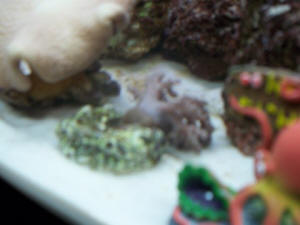
|
|
Clownfish swimming vertical against rock
10/23/10
Hi,
<Hello>
Set up is a 170 gallon reef tank (4ft by 4ft) with quite a bit of
live rock (sorry I don't know the exact amount), 2 metal
halide lights, live sand and coral, 3 green Chromis, 6 blue
damsel/ yellowtail damsels, one small starfish, 2 paired orange
clownfish (orcallis I believe) then 2 more black clownfish
(orcallis??), one black and white damsel, 2 emerald crabs, 2
cardinal fish 120 sump tank below with 3 chambers (Berlin
filtration setup, I think it's called), protein skimmer in
the first chamber, live sand, hermit crabs, live rock in the
second that filters over into a third chamber that cycles back up
in to the tank.
Water parameters are nitrate 0, PH is 8.4, ammonia is 0, nitrites
are 0 and have been that way for about 3 weeks steady now.
It's an established but moved tank (moved 4 weeks ago and is
to the point in re-cycling that the brown algae has turned to
green algae with a small amount of red showing up). Temperature
is 76 in the mornings going up to maybe 80 by evening.
Lights are on timers from 8 to 8.
Situation is the orange clowns were the original clownfish in the
tanks and seemed to be paired. We didn't know better and
thought we'd like to have two pairs of clowns in the
tank.
<Can/could be done in a system of this volume, shape>
After getting the second pair home, I found out that was a bad
idea. We did ask about compatibility at the fish store (the same
one we purchased the tank from and who set it up for us), nothing
was mentioned. Got the black clowns home, the two larger ones
(almost 2 inches) did a bit of spatting (nothing too vicious just
some slapping one another with their tails) but it settled down
that day.
They've been swimming together fine for almost two weeks with
the two larger fish mainly swimming together and the littler ones
(about 1 inch) following them. Last night I noticed the black,
larger clown looking like it was hiding in the LR with the other
three protecting the area it was hanging out in. The black fish
appears to be swimming against a rock face vertically in a little
alcove of sorts, the large orange is guarding really heavily, the
smaller ones are helping guard too. The large black fish comes
out to eat,
swims a bit and right back to the rock face. The large black fish
is opening and closing it's mouth a lot though (is this
labored breathing?).
<Might be>
None of the clowns appear to be fighting and only did that first
night, they actually look quite protective of the large black
one. I'm concerned because I have heard that two females
don't work well, I've read that a
female can change back to a male, I've read they can't
and will kill one off, I've read that some people have
successfully had two pairs in a tank, I've read some fish
mouthing might be Ich starting up (I see nothing to indicate that
though beside the maybe heavy breathing). Not really sure if I
should be concerned at this point or if perhaps they have laid
eggs that we can't see and are guarding the nest. What do you
think I am I seeing with this behavior?
<Likely the one fish hiding a bit, perhaps
submissive/signaling behavior.
Likely it is trying to adjust to the situation>
Sorry for the length of the email but I wanted to make sure and
give you all the details you might need.
Thanks,
Linda
<I would leave all as they are for now; likely all will settle
in w/ a few days time. Bob Fenner>
|
|
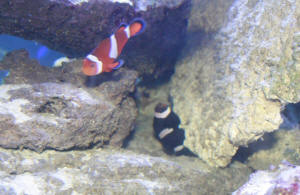 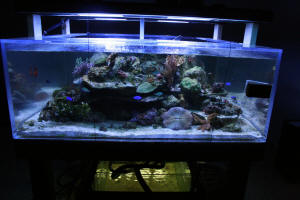
|
|
Mouth issue with powder blue tang,
RMF's go 10/23/10
Hello,
I've recently acquired a ~4" powder blue tang, and it is
in a 30 gallon quarantine tank since Wednesday (going on 3 days
now). I have not added any treatments or done any dips, as the
fish (surprisingly)
shows no sign of Ich or any other parasites.
<Mmmm>
However, I am curious and slightly concerned about the fish's
mouth. This is my first powder blue, and I am wondering if it is
normal for them to swim with their mouth open?
<Often, yes... this species lives in brisk water movement
conditions, w/ a good deal of consistently high dissolved
oxygen... And it takes a beating going from collection (in the
Indian Ocean) to consumers in the west... the process is
extremely trying, damaging to their blood make-up et al... This
fish is actually having a time "catching its
breath"...>
I've searched and came across "lock-jaw" and then
possibly missing skin around the teeth, but I'm not sure if
its anything I should be concerned about. I am attaching 2
pictures, the first is the original picture, the second is a
cropped, more zoomed-in focus on the mouth. It is eating Mysis
and spirulina brine, but seems to "chew" its food more
than usual (which I've never noticed with my Zebrasoma tangs
in other aquariums). I should also add that it is a timid
feeder... at first I thought the fish might be blind as it was
only taking food that would float by and almost land in his
mouth; I have since decided he is probably not blind, but
possibly just not sure what to do with the food?
<Not much to do... this fish should be "expedited"
through quarantine... I do strongly promote dips/baths... and
movement to large, stable quarters>
So far, no luck eating algae (I've tried rubberbanding it to
my tank ornament). It appears to be in good health otherwise, and
I do not see evidence of any pinching or "skinny-ness".
The QT contains water from the display tank, diluted down to
specific gravity of 1.020; could this be an issue?
<Ah, yes>
I still have it so low because the shipping bag it was received
in was 1.010.
<Not uncommon... you know the reasons for this?>
Other parameters - Nitrates/nitrites/ammonia are 0, pH is 8.0. I
am planning to do gradually increase the salinity by doing water
changes.
<Mmm, up to you. Do keep a close eye... mysterious mortalities
of Acanthurus leucosternon are very common... on this specimen,
move it as advised above and on WWM, if/when you see sign/s of
trouble>
Thank you for checking him out - I'm hoping I am just a
"worried parent", but I figure better to be safe than
sorry.
<Not easily kept... Do (re)read here:
http://wetwebmedia.com/powdbluetg.htm
and the linked files above. Bob Fenner>
Mouth issue with powder blue tang Acanthurus
Health\System, MikeV's go 10/23/2010
Hello,
<Hi Steve.>
I've recently acquired a ~4" powder blue tang, and it is
in a 30 gallon quarantine tank since Wednesday (going on 3 days
now). I have not added any treatments or done any dips, as the
fish (surprisingly) shows no sign of Ich or any other
parasites.
<Good for you on quarantining this fish. They tend to be more
susceptible to Ich than others >
However, I am curious and slightly concerned about the fish's
mouth. This is my first powder blue, and I am wondering if it is
normal for them to swim with their mouth open?
<To a degree, yes.>
I've searched and came across "lock-jaw" and then
possibly missing skin around the teeth, but I'm not sure if
its anything I should be concerned about. I am attaching 2
pictures, the first is the original picture, the second is a
cropped, more zoomed-in focus on the mouth.
<It looks a little beat up. Probably from being caught,
shipping, etc.
With good care, it will all heal.>
It is eating Mysis and spirulina brine, but seems to
"chew" its food more than usual (which I've never
noticed with my Zebrasoma tangs in other aquariums).
<I feed my Sailfin Tang Strips of Nori and Kombu, 'he'
regularly chews them.>
I should also add that it is a timid feeder...
<Very typical of this species. Keep a close eye when it is in
the main tank, it can be bullied by more aggressive
feeders>
at first I thought the fish might be blind as it was only taking
food that would float by and almost land in his mouth; I have
since decided he is probably not blind, but possibly just not
sure what to do with the food?
<Likely, or just stressed in his environment. It is a good
sign that it is eating. Give him a hiding place and keep the tank
temperature in the high 70s to low 80s (26 - 27 deg C) Do make
sure that the water is well aerated, tangs need a lot of
oxygen>
So far, no luck eating algae (I've tried rubberbanding it to
my tank ornament).
<It may take a while for it to get used to it, and recognize
that it is food. If your local pet store sells it, Caulerpa,
maiden's hair, or other macro algaes can be bought and used
to entice the fish to start eating greens. Just put the Nori
strips in and around the macroalgae.>
It appears to be in good health otherwise, and I do not see
evidence of any pinching or "skinny-ness".
<With Tangs, the place to look is right above and behind the
eyes.>
The QT contains water from the display tank, diluted down to
specific gravity of
1.020; could this be an issue?
<It most definitely isn't helping>
I still have it so low because the
shipping bag it was received in was 1.010.
<Yikes, that is low; wise to bring it up slowly.>
Other parameters -
Nitrates/nitrites/ammonia are 0, pH is 8.0.
<bring this up slowly to around 8.2.>
I am planning to do gradually increase the salinity by doing
water changes.
Thank you for checking him out - I'm hoping I am just a
"worried parent", but I figure better to be safe than
sorry.
<I would not worry here. Just keep a close eye on the fish,
slowly alter the tank conditions to better meet its needs. Powder
blues are tricky, and not the easiest fish to keep Have a read
here:
http://www.wetwebmedia.com/powdbluetg.htm
>
<MikeV>
|
|
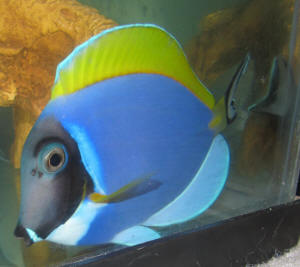 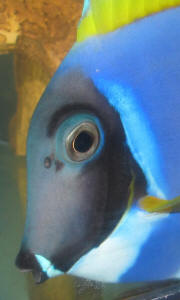
|
|
Stars and Stripes puffer 10/23/10
I have had a stars and stripes puffer fish for just about a year
now. Over the last week I have noticed that he has been putting
either fin into his gills but as soon as I get near the tank he
gets excited and which ever is in his gill they come out.
<Mmm, not to worry>
they will be out for the rest of the day until the next morning
when I wake up and find the fin in his gill again. he has no
white dots of any kind on him and he looks completely fine other
then this strange behavior. I did notice today though that he is
starting with the labored breathing. I don't have a QT tank
to put in him yet. I have to clean one up and then go buy some
salt if I need to get him in there as I just did a water change
and used up the last I had. I thought it could of been something
serious at the first discovering so I bought FURAN-2 by API
thinking this might fix the problem
<?>
but then he stopped doing this for about 2 days and now its
happening again. this medicine is supposed to cure Hemorrhagic
Septicemia, Body Slime & Eye Cloud, Open Red Sores, Fin &
Tail Rot, and Bacterial Gill Disease.
<And whatever else ails 'ya>
should I go ahead and get this QT running and treat with this
medicine??
<I would not>
or should I look into getting a new medication. I also just
recently changed out a Rena 55 filter to a Fluval fx5 yesterday
and 3 days ago I changed out a Aquatec 30-60 to a Fluval 405 used
all the media from those filters in the new filters so hopefully
I didn't do too much damage but all other tank mates are
fine. I have a 55 gal tank with 1 live rock and 4 salt water base
rock with crushed coral as the substrate water temp is 78-81 all
tests are good except for my nitrate which I have been for 2
years trying to lower is around 100ppm but everything is doing
good in the tank except for now.
<Do read here re NO3: http://wetwebmedia.com/nitratesmar.htm
and the linked files are control above>
this is why I have purchased these two big filters and filled
them with nitrate remover in hopes of getting the levels down. I
only have a Clown-fish, and a Fire-blood cleaner shrimp
<Strange that the puffer has not consumed this>
plus my (maybe sickly) stars and stripes puffer fish, oh and two
hermit crabs.
<And these>
I have read on forums that I could possibly be gill flukes and by
the sounds of it is a pain to get rid of 8 weeks in a QT tank
doing freshwater dips and what have you. please help in any way
you can. Thanks Chris.
<I'd just be patient here... Bob Fenner>
Stars and Strips Puffer fish
10/23/10
Hello I have recently contacted you about my stars and stripes
puffer fish asking about gill flukes or why he's putting his
fin in his gills. just an update on him he's swimming around
fine and dandy now both fins out and he's eating my live
rock.
<Good signs>
I'm guessing he's grinding his teeth as they grow like a
beaver. I have attached some photos of him in hopes of maybe you
can see anything that I am not.
<Appears fine to me>
unfortunately I don't have any of him having his fin in his
gills as when I last posted he was active and didn't have
them in. I tried to get some close ups of his eyes and various
shots of his body. hopefully you can see something I'm not or
maybe its just nothing. and as for his labored breathing since my
last post that seems to be fine too. I don't know what to do.
its just strange why he keeps putting his fin in the gills and
then is fine throughout the day.
thanks again Chris
<Welcome. BobF>
|
|
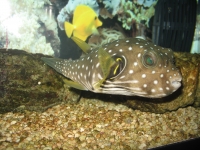 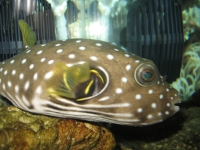
|
Ceramic Tile and the Like. Cnid. cult. -- 09/17/07
Cheers guys, thanks for everything that you do. <Welcome> I had a
quick question, I have searched everywhere but cannot seem to get a
straight answer so... I am setting up a SPS frag farm of sorts and have
a good amount of cultured pieces (say 60 in a 400 gal system). I have
been looking for bases to mount them on so the brood doesn't knock
in to each other. I have used ceramic tiles, but ran into some ph
issues <Mmm, the ceramic tile is not at fault here> which I
believe were caused by air conditioning (I took a sample outside,
aerated it, ph went up dramatically). Anyway, ph is stable and in check
(trough a couple of equipment mod.s), but I wanted to make sure there
are no ill effects from using ceramic tile in a system (I read on the
site they can be used for clownfish, but people would be just using a
few, not a mass amount of them). <This material is almost entirely
chemically inert> In addition, when I had the ph issues, many of my
colonies lost some color (there are no bugs, everybody gets dipped and
I have inspected all of them). I am seeing a return of color, but some
of them have taken on a whitish appearance but have good polyp
extension, it is almost as if they are getting burnt with too much
light. <A possibility... even with just change in water/light
transmission> I feed little if at all, <I would...> and I am
starting to wonder if perhaps my water is too polished <Yes... a
possibility> or perhaps I have a couple of bad ballasts. In the past
I used an ORP meter but it drove me nuts. <... Mmm, is a very useful
tool> Thanks for any comments or suggestions Tom <Well... if
you're serious re aquaculture here... I would look to more easily
manipulated plug material (there are a bunch available you can make or
just buy)... And I would feed SPS, other Cnidarians intentionally...
again if you're serious... And I would use the ORP meter, ozone...
much to chat up here. Bob Fenner>
SPS Accident - 5/8/2006 Hey everyone,
I had a little accident with an Acropora in my tank. I broke off four 1
inch long pieces - fragging by accident I guess. I have always wanted
to propagate my own coral to become more self sufficient in the hobby.
I have some small cylindrical bases for the coral and want to use reef
putty to connect the frags. My question is in regards to the base of
the frag being slightly buried in the putty. I need to get at least a
couple of millimetres into the putty to get the frags to stand. Is this
alright or should I try something else. Cheers Marc <Marc - Yes, it
is OK to stick the frag in. If it grows, the base will
eventually cover the putty. With new frags, it is usually
best to try to duplicate the same lighting and flow they had before
they broke off for best results. However, with a brand new
frag, you might want to start the frag lower in the tank and then move
it higher over the course of several days. Best of luck,
Roy>
SPS collection business 8/21/06 Dear
Bob and crew, <Alan> I'm thinking of starting an
exclusive Acropora collecting business to supply to the trade. I only
wish to collect Acroporas from the wild by fragging a few branches from
a colony and gluing them unto rocks for sale in order to minimize
impact on ecosystem. <Mmm... can't really be done this way...
need to collect colonies, keep them in captive conditions... some time
(months) later frag them... Too hard to make the transition
otherwise> I suppose this will generate faster returns rather than
having an aquaculture facility which requires more overhead cost and
time. <...> Do you think this is viable in the long run?
<Nope> Any words of wisdom? Thanks a lot. Best regards, Lee
<Keep studying, dreaming, planning... Bob Fenner>
SPS/Frags/Mother Colonies/Captive Generations'¦
10/6/05 Greetings Oh Great Fish God's, <Are you sure? I
swear I caught my Sailfin mouthing off the other day'¦>
Kudos for the exemplary work you guys and gals do on this site to
provide the vast knowledge base that you do and for sharing your
experiences with the rest of us wanabe reefers. It truly must be a
thankless task. <It's not so bad.> Question: Is a frag a frag
and will it always be a frag? <Not if it grows up, but I suppose
there is a lot of gray area in there.> I now have 2, 80gal tanks
that are brimming with assorted SPS corals and frags. I had initially
purchased mother colonies and after some time I began to frag them. I
am now at the point where I am fragging the frags into frags.
<Awesome.> Although all of the frags and the frags of the frags
are doing great but as they mature and grow they never seem to look
like the mother colony in density, color, or number of
appendages/bushiness. <Well unless they are placed in the
exact same conditions (noticed I said conditions not tank) a Frag will
never grow up to look exactly like its mother. There are so
many factors playing into this, nutrients, water flow, light, relation
to light, temperature of light among many others.> What
constitutes a mother colony? <In my opinion a colony large enough to
be fragged itself.> Size, age, it's density? <Probably all of
the above.> Or, must a mother colony come from the wild where it has
been naturally reproduced. <Not in my opinion. I have a
large Sinularia that I consider to be a mother colony. It was purchased
over 5 years ago as a captive propagated frag and is now a monstrous
size. I now make frags from it, so I consider it to be a mother colony.
Honestly though this can be relative, I suppose some say a true
'mother' colony must come from the wild.> Can a frag or a
fragged frag or a frag from a fragged frag ever become a mother colony
or is it doomed to a life of being just a simple
frag? <Jeez say that last sentence 5 times fast. Like I
said in my opinion if a frag has multiplied its original size
significantly and has thrived for a decent amount of time. If it is now
large enough to make frags without significantly reducing the colony,
then I consider it to be a mother colony. Of course I will
say that most of these questions seem to be relative or up to
opinion.> As mother colonies are fragged, and then the frags
fragged, is there anything lost in the genetics from the mother colony
as to the number of times it is fragged and re-fragged? <For the
most part frags are exact duplicates. Remember an Acropora species of
different color/shape/density can be the same species. That's why
some of them are so hard to identify.> Or would this ultimately lead
to healthier tank/captive raised specimen? <Yes consecutive
generations of captive propagated corals generally adapt a lot easier
to changes and captive life in general in comparison to their wild
counterparts. I would much rather purchase a captive propagated coral
over a wild specimen any day of the week.> Tanks in advance, <No
trouble, try not to over think or put labels on your specimens, the
fact that they are thriving and producing children should be good
enough. Have fun with it. Remember that most of these labels we use
including LPS and SPS are not scientific, they are hobby generated.>
Gary <Adam Jackson.> The Great White North
<The Great Southwest?>
|
|

